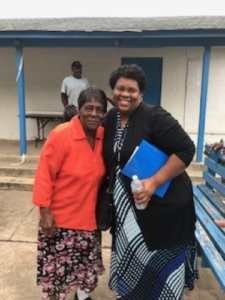This is a series spotlighting the grantees of the Hogg Foundation’s Collaborative Approaches to Well-Being in Rural Communities initiative. Check out others in this series on the good work happening in Bastrop County, Brooks County, Nacogdoches County and Victoria County.

Ms. Margine Mims, a longtime champion for Morris County, and Sherry Willis, of Alliance for Greater Works.
In July 2018, the Hogg Foundation awarded $4.5 million across six grantees of the Collaborative Approaches to Well-Being in Rural Communities (WRC) initiative. One grantee, Alliance for Greater Works, received funds to coordinate the initiative, and the other five—all in rural Texas counties—are using the funding to develop or build upon an existing collaborative to strengthen resilience, mental health and well-being in their communities.
Through this project, we seek to address the community conditions that contribute to mental health disparities leverage the power of shared decision-making to create and implement community-driven solutions. It’s a tall order; thus, we’ve given each collaborative three years to assess their community’s needs and assets, build new relationships, and identify strategies that lead to better mental health for everyone in their community. The grantees are in the first of these three years.
Today, we’re spotlighting one of the five community collaboratives, located in Morris County. Morris County Collaborative had its start as a community-led initiative organized by Ms. Margine Mims, a resident who continues to work tirelessly towards the betterment of her community. Now, with the fiscal support of Northeast Texas Community College, the Collaborative is bringing together local service providers, government officials, and community members to restore a sense of pride and hope throughout the county.
The Need
During World War II and shortly thereafter, a tubular steel plant operated by Lone Star Steel Company drew some 6,000 workers to Morris County. Although demographic and economic growth stagnated in the decades that followed, the small hub of households dependent on the plant would stay afloat until the late 1980’s, when a plunge in oil prices and rise in competitive foreign exports triggered layoffs by the thousands. Today, the county’s unemployment rate hovers around 8.6 percent—twice that of the state average.
The lack of development in Morris County has been greatly felt. The Robert Wood Johnson Foundation (RWJF) County Health Rankings, measuring for overall health outcomes across 242 Texas counties, place Morris County at 235, within the bottom five percent. Just one primary care physician in the area has services to offer—an unsustainable shortage that forces most of the 12,000 plus residents to travel either 45 miles to Longview or 80 miles to Tyler no matter the nature of the visit. Work commutes span similarly long distances for most. If times and spaces designated for coming together are scarce, the tasks of strengthening kinship and inspiring civic duty become far more formidable.
The Vision
To address the lack of close ties within the community of Morris County, the Collaborative plans on uniting medical facilities, nonprofit organizations, faith-based organizations, and other stakeholders to develop community outreach efforts for high-risk and underrepresented individuals and groups.
“There is a rich history here,” says Tammy Heinz, Hogg Foundation program officer and consumer and family liaison. “The community members are strong and proud that they’ve survived in spite of many challenges.”
Such effective collaboration would be unprecedented—and, crucially, can’t happen without the cooperation and contributions of all community members. To bring them into the fold, the Morris County Collaborative approach will use community-based participatory research, town hall meetings, and community events. Before funding from the foundation was even secured, Morris County Collaborative leaders managed to bring 130 Morris County residents to a town hall meeting to discuss the program’s priorities. Based on the feedback of attendees, the budget was completely revised.
“Our doors are open,” writes Beverly Austin, who handles the Collaborative’s public relations. “We have a lot to look forward together, and we need everyone’s perspective!”
